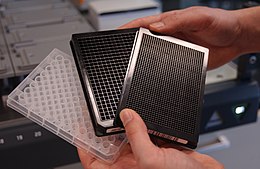Microtiter plate
A microtiter plate ( English microwell plate , from English well for shaft ) is a laboratory device for the investigation of biological properties, for example the absorption measurement in photometers or high-throughput screening (HTS (high-throughput screening)) in pharmaceuticals and Phytosanitary research.
construction
The mostly rectangular microtiter plates are usually made of plastic (usually polystyrene , sometimes also polyvinyl chloride ), and for very special applications also made of glass . They contain many isolated cells ( cavities , English wells ) in rows and columns. The exact dimensions (length × width × height) are 127.76 mm × 85.48 mm × 14.35 mm according to the ANSI standard recommended by the Society for Biomolecular Screening (SBS).
There is a multitude of formats, all on the same footprint and sometimes with variable heights:
| Cup | Filling volume (µl) |
||
|---|---|---|---|
| number | matrix | ||
| 6th | 2 × 3 | 2000 ... 5000 | |
| 12 | 3 × 4 | 2000 ... 4000 | |
| 24 | 4 × 6 | 500 ... 3000 | |
| 48 | 6 × 8 | 500 ... 1500 | |
| 96 | 8 × 12 | 100 ... 300 | |
| 384 | 16 × 24 | 30 ... 100 | |
| 1536 | 32 × 48 | 5… 15 | Use in UHTS (Ultra HTS) |
| 3456 | 48 × 72 | 1… 5 | |
The pans are available in different shapes: F-bottom (flat bottom), C-bottom (flat bottom with minimally rounded corners), V-bottom (conical bottom) and U-bottom (U-shaped recess).
Standardization has so far been carried out by the Society for Biomolecular Sciences as ANSI standards (ANSI / SBS 1-2004, ANSI / SBS 2-2004, ANSI / SBS 3-2004, ANSI / SBS 4-2004) and can be viewed here. Microtiter plates can be cleaned and sterilized with specially manufactured washing devices.
use
Microtiter plates are used for a wide variety of microbiological processes. Typical areas of application are cell cultivation or the screening of technical bioreactions. Due to the large number of cavities and the use of the same types, microtiter plates are suitable for cultivation and for tests with large numbers of samples.
The filling is usually done manually with multi-channel pipettes , in high throughput mostly with pipetting robots. A large number of devices ( plate readers ) are available for reading out the measurement results , which are specialized in certain chemical or physical changes. This makes it possible to test a large number (> 100,000) of different substances for a desired biological activity in a short time.
Individual evidence
- ^ Society for Biomolecular Sciences (Ed.): Microplate Standards Working Group - Published Standards. Retrieved February 12, 2009.


